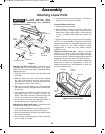
Assembly
'< .C<61 =<@@6/92 6;7B?F
1
6@0<;;20A =9B4 3?<: =<D2?
@<B?02 /23<?2 =2?3<?:6;4 .;F .@@2:/9F
.17B@A:2;A@<??2=.6?@
The dust collection system used on this tool is unique
because it is not attached to the upper guard. This
placement provides superior dust collection for the
majority of cuts. When adjusting or removing any dust
collection components, be sure the saw is unplugged.
9/<D
The elbow is attached to the top of the dust chute.
NOTE: It is recommended that the elbow is always in
place before operating the tool – it is required to direct
dust and debris away from the operator. The elbow
can be rotated in place. The elbow supports the dust
bag or can be connected to a vacuum cleaner.
%2:<C6;49/<D – For cleaning, the elbow may be
removed by pulling up and twisting until it is free of
the dust chute. Reattach the elbow by pressing and
twisting until it snaps over the chute’s molded-in
retaining ring. Always reattach before using the saw.
AA.056;4.;117B@A6;4A52B@A.4
AA.056;4.;1%2:<C6;4B@A.4 – The elbow
has pins on the top and bottom of the exit port which
will engage the coupler end of the dust bag
assembly. To attach the dust bag, align the coupler’s
slots with the elbow’s pins, then push and twist it
clockwise. To remove the dust bag, twist the coupler
counterclockwise, then pull off – always leave the
elbow on the dust chute (see Figure 6).
17B@A6;4B@A.4 – After attaching the bag, it is
recommended to do a “dry cut” before cutting with the
saw – this means: unplug the tool, preset it for
intended cut and practice the cut. For some bevel
cuts, the sliding fence may have to be moved or
removed to avoid being cut or making contact with
the dust bag. The bag’s position may also need a
rotating adjustment if it contacts the workpiece during
a slide cut.
64B?2
(@6;4.;192.;6;4A52B@A.4
(@6;4B@A.4 – Attach the clean bag to the elbow.
Adjust the elbow and dust bag, if necessary, so they
d
o not interfere with the tool during the intended
cutting operation.
92.;6;4B@A.4 – After the dust bag is 2/3 to 3/4
full, remove it from the saw. Bring the bag to a proper
container and pull open the zipper located on the
bottom of the bag. Hold the bag by the coupler end
and shake it vigorously until all the dust and debris
fall from it. Close zipper and reattach the bag.
NOTE: Clean the bag at the end of the cutting
session and before transporting or storing the saw
(see Figure 7).
2 2EA?2:29F 0.?23B9 D52;
16@=<@6;4 <3 1B@A !.A2?6.9@ 6;
36;2=.?A60923<?::.F/22E=9<@6C2<;<AA5?<D
@.D1B@A <; .; <=2; 36?2 &=<;A.;2<B@
0<:/B@A6<;6;A6:2:.F?2@B9A3?<:A52:6EAB?2
<3<69<?D.A2?D6A51B@A=.?A6092@
64B?2
Coupler
Zipper
Dust Bag
Dust Chute
Rubber Deflector
Elbow
*%""
!
Coupler
Slot
Pin
Dust Bag
Elbow
Dust Chute
*%""
!
@@2:/96;4B@A<9920A6<;&F@A2:
BM 2610007877 04-10:BM 2610007877 04-10.qxp 4/26/10 8:13 AM Page 15


















